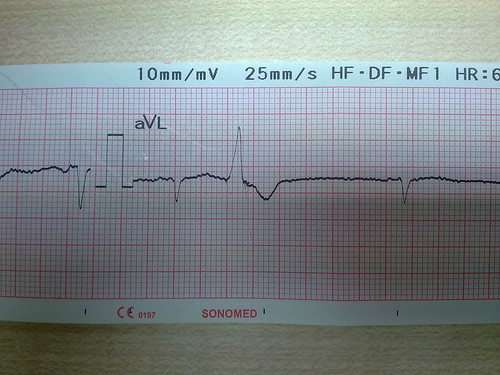A 46 year old man presented 8 days ago with fever and a fall. He had struck his head on the edge of a table during the fall. He never lost consciousness. When he was first seen by doctors, his blood pressure was low at 88/70mm Hg and he had a subconjunctival haemorrhage in his right eye. He was diagnosed to have septic shock and treated accordingly. When he complained of pain in his upper abdomen, an ultrasound of the abdomen was ordered and this showed features of acute acalculous cholecystitis. A CT scan of the head showed no skull fractures and no brain injury.
He was initially treated with Ceftriaxone, IV fluids and infusion of Dopamine. Blood cultures grew Pseudomonas aeroginosa in one and Burkholderia cepacia in the other.
His ECG showed sinus rhythm with ST segment elevation (concavity upwards) in chest leads V2 and V3.
In spite of treatment with Ceftriaxone, his fever persisted and, on day 5, Ceftriaxone was changed to Cefepime. Fever persisted in spite of this and, after seeing the second blood culture which grew Burkholderia, Ceftazidime replaced Cefepime. Two days after introducing Ceftazidime, he became afebrile. His blood pressure has been normal from the second day after admission. The Dopamine infusion was tapered and stopped after four days.
He is not a diabetic; his renal function is normal and his liver function tests are also normal.
Discussion
1. How was the diagnosis of acute acalculous cholecystitis made by ultrasound imaging?
Thickening of the wall of the gall bladder (wall thickness more than 3mm) is a diagnostic sign of acute cholecystitis. The absence of gall stones on imaging makes it acalculous. Apart from this, tenderness elicited by pressure on the ultrasound probe while imaging the gall bladder (sonographic Murphy’s sign) is also diagnostic.
Although acute acalculous cholecystitis is more common after abdominal trauma, it can occur in healthy, young and middle aged people in the community.
2. What are the common infections caused by Pseudomonas aeroginosa?
Pseudomonas aeroginosa is a gram-negative aerobic bacterium that is seen in water and moist soil. It can colonise human beings without producing disease. It can cause skin infections, cellulitis, otitis externa, and urinary infections in immune-competent hosts. In those who are immune-compromised, it can cause bacteremia and sepsis with resultant pneumonia, meningitis and endocarditis.
3. What is Burkholderia cepacia and what is its clinical significance?
Burkholderia cepacia was previously called Pseudomonas cepacia. It was first discovered as the cause of “onion rot”, a bacterial infection of onions. Now we know that it can be a cause of hospital acquired, catheter-related infections in the blood and urinary tract. It is also an important cause of infection in the lungs in those with cystic fibrosis.
4. Is there any significance to the ST elevation seen in the chest leads of this patient?
The ST elevation in this patient was limited to V2 and V3 and it was concave ST elevation. Hence, it is most likely not related to a myocardial infarction or to acute pericarditis. The absence of RBBB also rules out the Brugada syndrome. Transient ST elevation has been seen in patients with blunt chest trauma and attributed to cardiac contusion. This may be the reason for the ST elevation seen in this patient because he had presented after a fall. Of course, his ST elevation may have been a pre-existing finding, being a benign early repolarisation pattern. Repeat ECGs are necessary for a more accurate interpretation.
ST segment elevation is judged either in relation to the PR segment or the TP segment. If judged in relation to the PR segment, the J point is taken as the reference. If judged in relation to the TP segment, then a point 0.08sec after the J point is taken as the reference. ST segment elevation is considered to be significant only if it is more than 1mm in the limb leads or more than 2mm in the chest leads.
